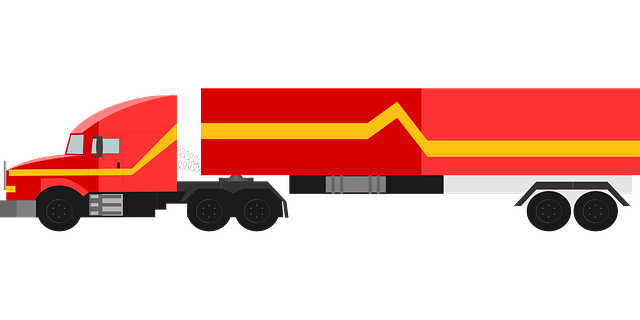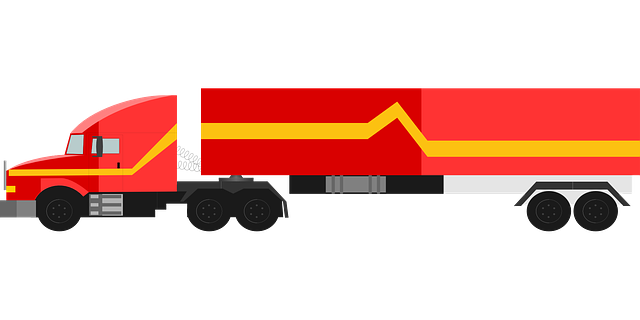The trucking industry's insurance landscape is complex, with comprehensive coverage being a necessity given the high risks associated with heavy-duty trucks in commerce. Insurers consider various factors when calculating premiums, including cargo type, transport distance, driver history, and whether the cargo is hazardous, which significantly affects liability risks and coverage costs. The scope of travel, from local to long-haul routes, impacts rates due to differing road exposure risks, while compliance with a patchwork of state-specific insurance regulations is critical for legal adherence across multiple jurisdictions. Fleet size, maintenance protocols, driver training programs, and safety records are also key factors in determining insurance costs. Insurers use telematics technology to monitor driving behavior, offering discounts for safe practices that can influence rates favorably. For trucking companies, understanding these variables is crucial for obtaining cost-effective and suitable insurance coverage that protects their operations against unexpected events. Proactive safety measures and the adoption of advanced telematics can lead to lower insurance costs by demonstrating a commitment to road safety and reducing risk profiles. Technological advancements, including big data analysis and usage-based insurance models, enable insurers to offer tailored premiums based on real-time data, promoting safer driving habits and cost savings within the trucking sector.
Navigating the complex landscape of insurance for heavy-duty trucks is a critical task for any trucking operation. This article delves into the pivotal factors that influence competitive rates in this niche market. From analyzing coverage options to deploying strategies for cost-effective insurance, we explore the essential elements that trucking companies must consider. Additionally, the impact of technological advancements and data analytics on shaping insurance rates within the sector is examined, offering insights to enhance both protection and profitability for your heavy-duty truck fleet. Whether you’re a seasoned carrier or new to the road, understanding these dynamics is key to securing the best coverage for your trucks.
- Understanding the Factors Influencing Competitive Heavy-Duty Truck Insurance Rates in the Trucking Industry
- Analyzing Coverage Options for Optimal Protection of Your Heavy-Duty Truck Fleet
- Strategies for Securing Cost-Effective Insurance for Your Heavy-Duty Truck Operations
- The Role of Technology and Data Analytics in Shaping Insurance Rates for the Trucking Sector
Understanding the Factors Influencing Competitive Heavy-Duty Truck Insurance Rates in the Trucking Industry

In the trucking industry, heavy-duty trucks are the lifeblood of commerce, and their insurance rates reflect the multifaceted risks associated with their operation. Carriers assess competitive rates by considering factors such as the type of cargo, the distance traveled, and the driving records of operators. The cargo being transported can significantly influence insurance premiums; hazardous materials typically come with higher liability risks, necessitating more robust coverage. Additionally, the frequency and distances of trips undertaken by these trucks play a crucial role in determining rates; long-haul routes, for instance, might attract different pricing compared to local deliveries due to varying exposure to risk on the road.
Operators must also navigate the complexities of insurance regulations that vary from state to state. Compliance with these regulations is non-negotiable and affects the cost of insurance as carriers must ensure their policies align with legal requirements across different jurisdictions. Fleet size, maintenance practices, driver training programs, and safety records are additional factors that carriers examine when calculating competitive rates for heavy-duty truck insurance. Insurers often leverage advanced telematics to monitor driving behavior, offering potential discounts for safe driving habits, which further influences the overall cost of insurance in the trucking sector. Understanding these variables is essential for trucking companies to secure cost-effective coverage that aligns with their operational risks and financial considerations.
Analyzing Coverage Options for Optimal Protection of Your Heavy-Duty Truck Fleet

When managing a heavy-duty truck fleet, securing comprehensive insurance coverage is paramount to safeguard your investment and mitigate potential financial losses due to accidents, damages, or liability claims. In analyzing coverage options, it’s crucial to consider the diverse risks associated with heavy-duty trucks, including cargo loss, equipment breakdowns, and operational downtime. Opting for insurance policies that cover these eventualities ensures that your fleet is well-protected against a wide array of unforeseen circumstances. Additionally, evaluating different insurers’ offerings can lead to competitive rates without compromising the quality of coverage. Comparing deductibles, liability limits, and additional protections like on-hook expenses or trailer interchange coverage will help tailor a policy that aligns with your fleet’s specific needs and risk profile. Carriers offering trucking insurance often provide specialized policies that account for the unique exposures within the industry, thereby offering optimal protection for your heavy-duty truck fleet.
Strategies for Securing Cost-Effective Insurance for Your Heavy-Duty Truck Operations

To effectively manage insurance costs for your heavy-duty truck operations, it’s advisable to conduct thorough market research. Evaluate various insurance providers to compare coverage options and rates. Engaging with multiple insurers can yield a competitive quote that aligns with your budgetary constraints without compromising on essential protections for your fleet. Additionally, consider the size and usage patterns of your trucks, as these factors significantly influence insurance premiums. Operators with larger or frequently used trucks may find specialized policies tailored to their needs, often at more favorable rates when bundled with other coverage options.
Investing in safety programs and technology can also lead to reduced insurance rates for heavy-duty truck operations. Implementing advanced telematics systems that monitor driving behavior can demonstrate a commitment to road safety, potentially qualifying your business for preferential rates from insurers. Furthermore, maintaining a clean driving record and providing comprehensive training for drivers contribute to a lower risk profile, which insurers often reflect in their pricing. By adopting these strategies, trucking companies can secure cost-effective insurance while ensuring the longevity and profitability of their operations.
The Role of Technology and Data Analytics in Shaping Insurance Rates for the Trucking Sector

In the realm of commercial insurance, the trucking sector has witnessed a transformative impact due to advancements in technology and data analytics. Insurance providers now leverage sophisticated algorithms and big data to assess risk more accurately, leading to tailored insurance rates for trucking operations. Real-time monitoring devices installed on heavy-duty trucks gather vast amounts of operational data, which insurers analyze to understand driving patterns, vehicle performance, and environmental conditions. This granular insight enables insurers to offer competitive rates that reflect the actual risk profile of each truck and its driver, fostering a more equitable insurance market within the trucking industry.
The integration of telematics and usage-based insurance (UBI) models further refines the pricing process. UBI policies, for instance, adjust premiums based on empirical data collected from the trucks themselves, such as mileage, speed, and braking patterns. This approach not only aligns insurance costs with real-world risk but also incentivizes safer driving practices, ultimately reducing accidents and claims across the trucking sector. Consequently, insurance carriers can offer lower rates to those who demonstrate safe driving habits, creating a positive feedback loop that promotes both safety and cost efficiency in the industry.
In the dynamic landscape of the trucking industry, securing competitive heavy-duty truck insurance rates is a critical component for operational resilience. This article has shed light on the various factors that influence these rates, from comprehensive coverage options to the strategic use of technology and data analytics. By understanding the intricacies of insurance policies and implementing cost-effective measures, fleet owners can protect their investments while ensuring compliance with industry standards. As the sector continues to evolve with advancements in tech, staying informed and proactive will remain key to navigating the insurance market effectively. Trucking businesses that prioritize these insights are well-positioned to thrive amidst the challenges and opportunities of this robust field.
